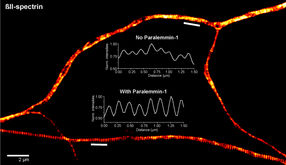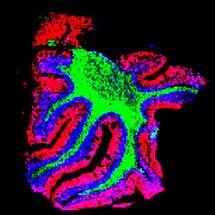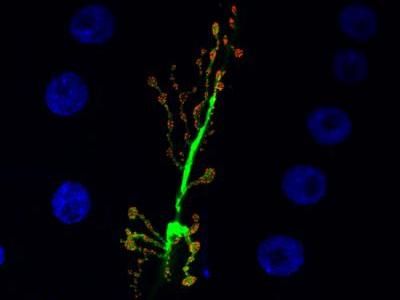Inflammation Values by Spectrometry
Quantifying acute-phase inflammation proteins by NMR
The analysis of all small molecules in an organism (the metabolome) has huge potential for medical diagnostics. A German research team is investigating this with nuclear magnetic resonance spectrometry (NMR). In a study recently published in Angewandte Chemie, they quantified acute-phase proteins from serum samples that act as markers for inflammatory diseases. They successfully obtained several diagnostic parameters from a single, short, NMR experiment.

© Wiley-VCH
In addition to genomics and proteomics, metabolomics is becoming established as another mainstay of medical research and diagnosis. Bodily fluids like blood are highly complex mixtures of only partially known compounds. Metabolomic analysis is thus correspondingly difficult and complex. A team led by Ulrich L. Günther and Alvaro Mallagaray uses advanced NMR techniques to link the metabolomes of cells and organisms to diseases.
NMR spectroscopy (NMR = nuclear magnetic resonance) is based on the behavior – which varies depending on the chemical environment – of magnetically active atomic nuclei, primarily hydrogen (1H) and carbon (13C) under the influence of a strong external magnetic field. Using this phenomenon, it is possible to obtain measurements and characteristic spectra. In medical diagnosis, this principle is also used in the form of MRI (magnetic resonance imaging) to image tissue.
In prior studies, NMR measurements of blood serum produced signals for special carbohydrate building blocks (acetyl resonances of N-acetylated carbohydrates) that are linked to acute-phase glycoproteins. These carbohydrate-containing proteins arise in cases of strong immune responses to acute inflammation. As well as changes in their concentration, their glycosylation pattern -- meaning the type, number, and arrangement of their carbohydrate building blocks – can vary in a specific way depending on the disease in question.
The team employed a series of different NMR processes to fully assign the NMR signals from human serum. This led them to the conclusion that the two strongest signals, designated as glycoproteins A and B, result from N-acetylneuraminic acid and N-acetylglucosamine building blocks, respectively, which contradicts a hypothesis proposed in a prior study. By using diffusion-edited NMR experiments, they were able to prove that the components of these signals can be tied to specific, acute-phase proteins.
“NMR spectra allow for the simultaneous quantification of several acute-phase inflammation proteins,” according to Ulrich L. Günther. “A proteo-metabolomic NMR signature of significant diagnostic potential is obtained within 10-20 minutes.” Working at the Universities of Lübeck and Oldenburg, the University Hospitals of Greifswald and Lübeck, the University Heart Center in Lübeck, and the German Center for Cardiogenic Vascular Research (Greifswald and Lübeck), the team was able to use serum samples from patients with COVID-19 or cardiogenic shock, a dangerous side effect of heart attacks. In comparison to samples from healthy individuals, they found significant changes in various specific acute-phase proteins in the serum. In the case of Parkinson’s disease, our method provides a yes-no diagnosis, as Parkinson’s patients have a very specific glycosylation in their blood that does not occur in healthy people,” Günther adds.
Original publication
Other news from the department science

Get the analytics and lab tech industry in your inbox
By submitting this form you agree that LUMITOS AG will send you the newsletter(s) selected above by email. Your data will not be passed on to third parties. Your data will be stored and processed in accordance with our data protection regulations. LUMITOS may contact you by email for the purpose of advertising or market and opinion surveys. You can revoke your consent at any time without giving reasons to LUMITOS AG, Ernst-Augustin-Str. 2, 12489 Berlin, Germany or by e-mail at revoke@lumitos.com with effect for the future. In addition, each email contains a link to unsubscribe from the corresponding newsletter.
Most read news
More news from our other portals
See the theme worlds for related content
Topic World Spectroscopy
Investigation with spectroscopy gives us unique insights into the composition and structure of materials. From UV-Vis spectroscopy to infrared and Raman spectroscopy to fluorescence and atomic absorption spectroscopy, spectroscopy offers us a wide range of analytical techniques to precisely characterize substances. Immerse yourself in the fascinating world of spectroscopy!

Topic World Spectroscopy
Investigation with spectroscopy gives us unique insights into the composition and structure of materials. From UV-Vis spectroscopy to infrared and Raman spectroscopy to fluorescence and atomic absorption spectroscopy, spectroscopy offers us a wide range of analytical techniques to precisely characterize substances. Immerse yourself in the fascinating world of spectroscopy!
Topic world Diagnostics
Diagnostics is at the heart of modern medicine and forms a crucial interface between research and patient care in the biotech and pharmaceutical industries. It not only enables early detection and monitoring of disease, but also plays a central role in individualized medicine by enabling targeted therapies based on an individual's genetic and molecular signature.

Topic world Diagnostics
Diagnostics is at the heart of modern medicine and forms a crucial interface between research and patient care in the biotech and pharmaceutical industries. It not only enables early detection and monitoring of disease, but also plays a central role in individualized medicine by enabling targeted therapies based on an individual's genetic and molecular signature.





























































